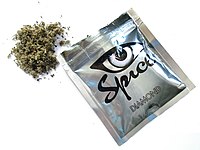
Photo from wikipedia
Synthetic cannabinoids (SCs) are the most chemically diverse group of new psychoactive substances. This group has been associated with several intoxications, many with fatal outcomes. Although advancements have been achieved… Click to show full abstract
Synthetic cannabinoids (SCs) are the most chemically diverse group of new psychoactive substances. This group has been associated with several intoxications, many with fatal outcomes. Although advancements have been achieved in pharmacology, metabolism, and detection of these compounds in recent years, these aspects are still unresolved for many SCs. The aim of this study was to investigate the in vitro potency of 14 indole- and indazole-based SCs by applying a stable CB1 or CB2 receptor activation assay and correlating the activity with their structure. The half-maximal effective concentration (EC50 ) of 5-chloropentyl, 5-bromopentyl, and 5-iodopentyl JWH-122 analogs varied from 74.1 to 283.7 nM for CB1 and 7.05 to 23.4 nM for CB2, where the addition of a chlorine atom enhanced the potency at CB1 compared with the bromo and iodo analogs. AM-2201 was the most active at CB1 within this naphthoylindole family, with an EC50 of 23.5 nM but with the lowest efficacy (Emax 98.8%). Within the indole-3-carboxamide derivatives, 5F-MDMB-PICA was the most active compound, with a CB1/CB2 EC50 of 3.26/0.87 nM and an Emax around three times higher than JWH-018. ADB-FUBINACA was the most potent tested SC overall, with a CB1/CB2 EC50 of 0.69/0.59 nM, and an Emax around 3-fold higher than that for JWH-018 at CB1. The data obtained in this study confirm how small differences in the structure of SCs might lead to large differences in their activity, especially at CB1, which may be correlated with differences in their toxic effects in humans.
Journal Title: Drug testing and analysis
Year Published: 2019
Link to full text (if available)
Share on Social Media: Sign Up to like & get
recommendations!